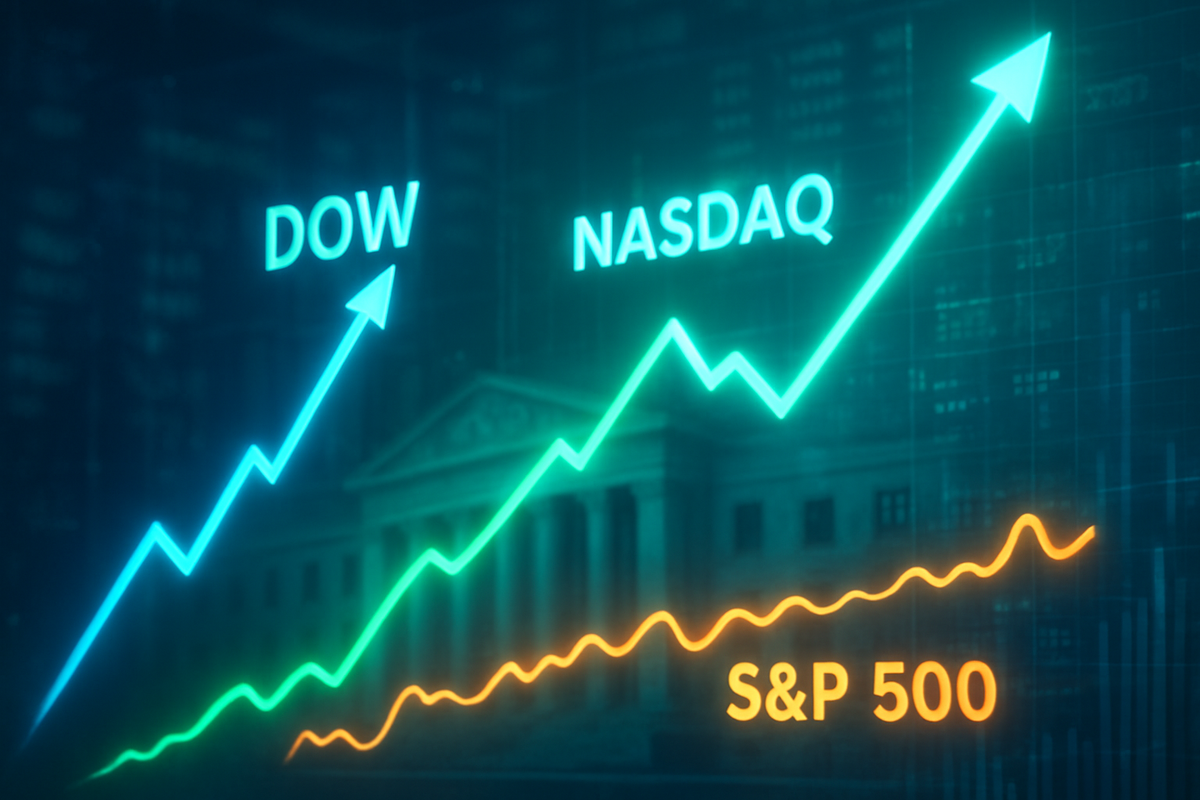
Washington D.C. (October 28, 2025) – As the Federal Reserve's highly anticipated two-day policy meeting commences today, the U.S. stock market presents a curious dichotomy: the Dow Jones Industrial Average and the Nasdaq Composite are scaling new all-time highs, while the broader S&P 500 shows signs of an underlying "wobble," masking a concentrated rally. This mixed performance underscores a market grappling with robust optimism fueled by anticipated rate cuts, yet shadowed by concerns over market breadth and elevated valuations.
The divergence highlights a critical moment for investors as the Federal Open Market Committee (FOMC) deliberates on its next monetary policy move. With strong expectations for another quarter-point interest rate cut, the market is betting on the Fed's dovish stance to sustain growth. However, the uneven distribution of these gains raises questions about the sustainability and health of the current rally.
The Fed's Deliberation and a Divergent Market
The Federal Reserve's two-day policy meeting, spanning October 28-29, 2025, is the focal point of market attention. Following a 25 basis point rate cut in September 2025, which brought the federal funds rate target range to 4.00%-4.25%, the market is largely pricing in another similar reduction, potentially lowering the rate to 3.75%-4%. This proactive approach by the Fed is seen as a "risk management cut" aimed at preventing a further slowdown in the labor market, despite inflation lingering above the 2% target at 3.0% in September.
Leading up to this pivotal meeting, the major U.S. indices displayed remarkable strength. On Friday, October 24, and Monday, October 27, 2025, all three major indices—the Dow Jones Industrial Average (DJIA), S&P 500 (SPX), and Nasdaq Composite (IXIC)—surged to fresh all-time highs. The Dow notably closed above 47,000 for the first time, while the S&P 500 climbed 0.8% and the Nasdaq Composite gained 1.2% on October 27. However, beneath the surface of the S&P 500's record-setting performance, a significant divergence emerged. The "equal-weight S&P 500," which gives equal importance to all 500 constituent companies, was up only 0.44% on October 27, significantly underperforming the market-cap-weighted S&P 500's 1.23% gain. This disparity suggests that the rally is heavily concentrated in a few mega-cap technology stocks, rather than being broad-based. Adding to the caution, early trading on October 28 saw Nasdaq 100, S&P 500, and Dow futures largely unchanged, with retail investor sentiment reportedly "bearish" for S&P 500 and Nasdaq 100 ETFs. This internal weakness within the S&P 500, even as its headline number reaches records, paints a picture of selective strength rather than widespread market exuberance.
The primary driver behind this divergence is the outsized influence of a handful of mega-cap technology companies, often dubbed the "Magnificent Seven." These companies wield an immense impact on cap-weighted indices like the S&P 500 and Nasdaq Composite. Their robust performance can lift the entire index, even if a majority of other stocks are struggling or merely treading water. The anticipation of lower interest rates further fuels optimism for these growth-oriented tech giants, as reduced borrowing costs improve their future earnings outlook and make their high valuations more palatable. Coupled with positive geopolitical developments, such as a reported U.S.-China trade framework agreement, these factors create a complex environment where headline gains might not reflect the true health of the broader market.
Companies Navigating the Crosscurrents
In this environment of divergent market performance, certain companies and sectors are poised to benefit, while others may face headwinds or continue to underperform. The "Magnificent Seven" – Apple (NASDAQ: AAPL), Microsoft (NASDAQ: MSFT), Amazon (NASDAQ: AMZN), Alphabet (NASDAQ: GOOGL), Nvidia (NASDAQ: NVDA), Tesla (NASDAQ: TSLA), and Meta Platforms (NASDAQ: META) – are the clear beneficiaries of the current market dynamic. Their substantial market capitalizations mean that even modest gains from these titans can significantly propel the S&P 500 and Nasdaq Composite. Lower interest rates typically enhance the valuation of growth stocks by reducing the discount rate applied to their future earnings, making their long-term growth prospects more attractive. This trend is likely to continue as long as the Fed maintains its dovish stance.
Beyond the mega-cap tech realm, other growth-oriented companies, particularly those in innovative technology sectors or with strong balance sheets, may also find tailwinds from a lower interest rate environment. Reduced borrowing costs can encourage investment in expansion, research and development, and mergers and acquisitions, fostering further growth. Companies with significant debt loads could also see their interest expenses decrease, improving their profitability. However, the gains might be less pronounced compared to the market leaders.
Conversely, companies outside the mega-cap tech sphere, especially those in more traditional or cyclical industries, might struggle to keep pace. The "wobble" in the equal-weight S&P 500 suggests that a vast number of companies are not participating in the rally to the same extent. Value stocks, which often thrive in environments of broad economic growth and higher interest rates, could continue to underperform if investors remain fixated on high-growth narratives. Furthermore, if the Fed's rate cuts are indeed a response to a weakening labor market or broader economic concerns, then companies sensitive to economic downturns, regardless of their sector, could face pressure on their revenues and earnings. Retail investors, whose sentiment for S&P 500 and Nasdaq 100 ETFs is reportedly bearish, might be signaling a cautious outlook on the broader market's ability to sustain these highs beyond the top performers.
Broader Implications and Historical Parallels
The current market dynamic, characterized by record highs driven by a narrow set of mega-cap stocks amidst a broader market wobble, carries significant wider implications. It highlights a continuing trend of market concentration, where a small number of companies disproportionately influence overall index performance. This can lead to a less diversified market, where the fortunes of a few dictate the health of the many. For investors, it means that a cap-weighted index fund, while showing strong returns, might not truly reflect the performance of the majority of companies within that index.
The ripple effects of this concentration extend to competitors and partners. Smaller tech companies or those in other sectors may find it harder to attract capital and talent when investor focus is overwhelmingly on the established giants. Furthermore, the reliance on a few companies for market gains introduces systemic risk; any significant setback for one of the "Magnificent Seven" could have a magnified negative impact on the entire market. From a regulatory standpoint, sustained market concentration might draw increased scrutiny regarding antitrust concerns or market fairness, though immediate policy implications are not yet apparent.
Historically, periods of extreme market concentration have often preceded periods of increased volatility or corrections. The research points to the Shiller CAPE ratio, a measure of market valuation, being at high levels, second only to the dot-com peak in 1999. This comparison serves as a potent historical precedent, reminding investors that while innovation and growth can drive markets to unprecedented heights, valuations eventually matter. During the dot-com bubble, a few internet and technology stocks soared, pulling up the indices, only to face a dramatic correction when the broader market fundamentals failed to catch up. While today's mega-cap tech companies are fundamentally stronger and more profitable than many dot-com era firms, the principle of concentrated gains and elevated valuations still warrants caution.
The Path Forward: Scenarios and Adaptations
Looking ahead, the immediate future hinges on the outcome of the Federal Reserve's policy meeting. A widely anticipated rate cut would likely provide a short-term boost to market sentiment, particularly for growth stocks. However, the language used by the Fed in its statement and during the subsequent press conference will be crucial. Any hints about future policy direction, especially regarding the balance between addressing inflation and supporting the labor market, will significantly shape investor expectations for the coming months.
In the long term, the sustainability of the current tech-led rally is a key question. If the broader economy, including the labor market, strengthens without a resurgence of inflation, the Fed might pause its rate-cutting cycle. This could lead to a rotation out of high-valuation growth stocks into more cyclical or value-oriented sectors, potentially broadening the market rally. Conversely, if economic weakness persists or deepens, the Fed might be compelled to implement further cuts, which could further entrench the dominance of mega-cap tech as investors seek perceived safe havens of growth. Companies will need to strategically adapt, with those outside the tech giants potentially focusing on efficiency, niche market leadership, or robust dividend policies to attract investors.
Market opportunities may continue to lie within the innovation hubs of the technology sector, but investors might also begin to explore undervalued segments of the market that could benefit from a eventual broadening of economic recovery. Challenges include navigating potential market corrections if valuations become unsustainable, or if unexpected economic shocks occur. Scenarios range from a "soft landing" where the Fed successfully engineers sustained growth with controlled inflation, to a more challenging environment where economic headwinds lead to increased volatility and a re-evaluation of current market leaders.
Wrap-Up: Navigating a Nuanced Market
The current financial landscape is defined by a nuanced and somewhat contradictory narrative: headline-grabbing record highs for the Dow and Nasdaq, juxtaposed with an underlying fragility within the S&P 500. This divergence is largely attributable to the overwhelming influence of a select group of mega-cap technology companies, whose performance is being amplified by the Federal Reserve's dovish monetary policy. The ongoing Fed meeting on October 28-29, 2025, is a critical juncture that will likely set the tone for market sentiment in the near term.
Moving forward, investors must look beyond headline index numbers and scrutinize market breadth. While the "Magnificent Seven" continue to deliver impressive returns, a truly healthy market requires broader participation. The elevated Shiller CAPE ratio serves as a stark reminder of historical parallels, urging caution even amidst widespread optimism. The coming months will test the resilience of the current market structure and the Fed's ability to navigate the delicate balance between supporting growth and managing inflation.
Investors should closely monitor the Fed's post-meeting statements for clues on future monetary policy, pay keen attention to inflation data and labor market reports, and analyze earnings reports from both mega-cap tech and a wider array of companies to gauge the true health of the economy. Diversification and a clear understanding of individual company fundamentals will be paramount in navigating this complex and potentially volatile market environment.
This content is intended for informational purposes only and is not financial advice






